Table of Contents
What is Kaizen?
Kaizen is a Japanese word made out of two words. Kai and Zen. Kai means change and Zen means for the better.
Kaizen is core to the concept of lean manufacturing and helps reduce 7 types of waste, through the concept of continuous improvement.
Kaizen stands on the concept of participation. It increments the role of the process owner and involves encouraging process owners to take small improvement actions, leading to continuous improvement.
The following quote from the founder of Kaizen Institute presents the definition of Kaizen in the simplest form.
“KAIZEN means continuing improvement involving everyone – managers and workers alike.”
Masaaki Imai
It’s a proactive approach to achieving regular, incremental improvements to the manufacturing process. In a sense, it combines the collective talents within a company to create a powerful engine for improvement.
What if I ask you to improve 0.01% every day for the next year. It would seem to be an insignificant act at the start. But if you keep on doing it for one year on a consistent basis, you would be 38 times a better version of your current self at the end of the year. Isn’t it amazing?
The same is true for Kaizen’s small improvement activities, which seem insignificant at the start but the benefits are immense.
Let’s dig deeper!
Types of Kaizen
Following are the types of Kaizen :
#1 Point Kaizen
There are many different ways to implement kaizen in your business, and one of the most effective is through “point kaizen.”
Point kaizen is a process where small teams of employees are focused on solving a specific problem or improving a specific process. The goal is to make incremental improvements that will add up over time.
This entails improving a point in the value stream, For example :
- Machine Change over
- Material Handling
- Ergonomics
Point kaizen is an effective way to solve problems because it taps into the collective wisdom of the team. By involving everyone in the process, you’re more likely to come up with a successful solution. And by tracking the results, you can be sure that the solutions you implement are actually making a difference.
Every member of the organization has to participate in the Kaizen process at different stages for optimal implementation of the Kaizen Process. But it is not necessary that every member should get involved for each type of kaizen.
For example, Vice President getting involved in Point Kaizen is not such an optimal process.
#2 Flow Kaizen
Flow kaizen is a type of kaizen that is focused on improving the flow of work. The goal is to make sure that work moves smoothly from one step to the next, without any unnecessary delays or interruptions.
Flow kaizen is an effective way to improve the flow of work because it helps businesses identify bottlenecks and other issues that are causing delays. By taking small steps and involving everyone in the process, kaizen can lead to big improvements over time.
This entails several point kaizens leading to improvement in the overall flow. We can say it is the sum of multiple point kaizens. It is oriented to the flow of material/ information.
Example- Re-organization of the production line.
#3 System Kaizen
System Kaizen involves a complete overhaul of the value stream for a particular system of organization. Typical system Kaizen focuses on Man, Machine, Material Systems, or core business processes such as budgeting.
The goal is to make sure that all aspects of the system are working together smoothly and efficiently.
System kaizen is an effective way to improve the overall system because it helps businesses identify and correct problems before they become serious.
For the implementation of each type of kaizen teams are typically made up of 5-10 people, and they meet for a few hours each week to work on their project. The team leader is responsible for keeping the team focused and on track. Each team member brings their own ideas and expertise to the table, and together they brainstorm solutions to the problem at hand.
Once the team comes up with a solution, they implement it and then track the results. If the solution is successful, it becomes a permanent part of the process. If not, the team goes back to the drawing board and comes up with a new solution.
How does Kaizen work?
Kaizen is a Japanese word that means “improvement.” It is a philosophy or mindset for continuous improvement in all aspects of life. Kaizen is based on the idea that small changes made over time can result in big improvements.
In business, kaizen is often used as a way to improve productivity and quality. Many companies use Kaizen principles to help employees think creatively about ways to improve their work.
Kaizen can be applied to any area of life, but it is most commonly used in businesses. In a business setting, kaizen principles are often used to improve quality, productivity, and customer satisfaction. Kaizen can be used to improve any process, from manufacturing to office work.
The key to kaizen is taking small steps, or kaizen baby steps, to make gradual improvements over time. kaizen is about making permanent changes in your behavior, rather than temporary changes that you will eventually revert back to.
When you’re trying to make a change in your life, it’s easy to get overwhelmed and give up before you’ve even really started. This is where kaizen can help. By breaking down your goals into small, manageable steps, kaizen makes it more likely that you’ll stick with your plan and achieve your goals.
For example, let’s say you want to start exercising more. Rather than setting a goal of working out for two hours every day, which is probably not realistic or sustainable, you could set a kaizen goal of walking for 10 minutes every day.
This small goal is much more achievable, and it’s also something that you can build on overtime. Once you’ve made walking a daily habit, you can gradually increase the intensity and duration of your workouts.
But Kaizen isn’t just about achieving your goals; it’s also about improving your process along the way. As you’re working towards your goal, take time to reflect on your progress and identify areas where you can improve. This could be anything from streamlining your morning routine to finding a more effective way to study for exams. By constantly evaluating and improving your process, you’ll not only achieve your goals more efficiently, but you’ll also set yourself up for success in the future.
Kaizen is often used in conjunction with other quality improvement tools, such as Six Sigma and Lean Manufacturing. When used together, these tools can help businesses achieve amazing results.
What are the Kaizen Principles?
The Kaizen principles are:
- Start by questioning the best practices
- Follow the principle of Continuous improvement
- Kaizen is a team effort
- Reframe problems as opportunities
- Make decisions based on data
- Practice the “Five Why” Method
- Be Economical
- Look for simple, incremental solutions
- Respect for people
- Kaizen is often used in conjunction with other quality improvement tools, such as Six Sigma and Lean Manufacturing.
- Embrace Change or Keep your mind open to change
- Kaizen principles can be applied to any area of life
Who should use Kaizen?
Kaizen is a philosophy of continuous improvement that can be used by anyone in any field.
The kaizen philosophy can be traced back to Deming’s 14 Points, which were a set of principles for quality management developed by W. Edwards Deming. One of Deming’s points was “Continuous improvement.” The kaizen philosophy took this idea and ran with it, further developing the concepts of continuous improvement and applying them to all aspects of life.
Kaizen is often used in business settings, but it can be applied to any area of your life. For example, you could use kaizen to improve your health, relationships, finances, or personal productivity.
How can you implement kaizen in your business?
There are many ways to implement kaizen in your business. Some ideas include:
1. Encourage employees to suggest improvements.
2. Set aside time each week for kaizen activities.
3. Hold kaizen events or “kaizen blitzes” to focus on a specific area for improvement.
4. Train employees in kaizen principles and quality improvement tools.
5. Use quality circles or teams to identify and solve problems.
6. Implement Just-in-Time (JIT) manufacturing or other Lean Manufacturing techniques.
7. Conduct regular audits of your processes and look for ways to improve them.
8. Hire a kaizen consultant to help you get started.
Kaizen is a powerful tool that can help businesses achieve amazing results. By taking small steps and involving everyone in the organization, kaizen can lead to big improvements over time.
Benefits of Kaizen
Following are some of the benefits you can achieve through Kaizen :
#1 Improved quality
Kaizen is all about continuous improvement, and that can only happen if you’re willing to change the way you do things. Sometimes, this means trying new things that may seem a bit risky. But remember, Kaizen is all about making small changes that lead to big results. So don’t be afraid to experiment.
#2 Increased productivity
When you use kaizen principles in your business, you can achieve amazing results in terms of productivity. For example, you could start by setting a goal to reduce the amount of time it takes to complete a task by 5%. Then, you could track your progress and make further adjustments as needed. By making small changes on a continual basis, you can dramatically improve your productivity.
#3 Greater customer satisfaction
kaizen can also help you improve quality, which will lead to greater customer satisfaction. For example, if you’re a manufacturer, you could use Kaizen principles to eliminate defects in your products. Or, if you’re a retailer, you could use Kaizen principles to improve the quality of your customer service. By continuously improving quality, you can achieve amazing results in terms of customer satisfaction.
#4 Improved employee morale
When kaizen principles are used in the workplace, employees feel empowered to make changes and contribute to the continuous improvement process. This can lead to improved morale and increased motivation. And when employees are motivated, they’re more likely to be productive and produce high-quality work.
#5 Lower costs
Kaizen can also help businesses save money. For example, if you’re a manufacturer, you could use Kaizen principles to reduce waste and improve efficiency. As a result, you’ll be able to produce more products at a lower cost. kaizen can also help businesses save money by reducing the need for rework and repairs.
#6 Increased profits
kaizen can help businesses increase profits in many ways. For example, by using Kaizen principles to improve quality, you can charge higher prices for your products. Or, by using Kaizen principles to improve productivity, you can produce more products in less time, which will lead to increased profits.
#7 A competitive advantage
When you use kaizen principles in your business, you can achieve a competitive advantage. For example, if you’re a manufacturer, you could use Kaizen principles to reduce the amount of time it takes to produce a product. This would allow you to get your products to market faster than your competitors. Or, if you’re a retailer, you could use Kaizen principles to improve the quality of your customer service. This would give you an edge over other retailers who don’t provide such high-level customer service.
#8 A culture of continuous improvement
When kaizen principles are used in an organization, they help create a culture of continuous improvement. In such a culture, employees are constantly looking for ways to improve quality and productivity. And when employees are empowered to make changes, they’re more likely to be motivated and productive.
#9 Improved teamwork
kaizen can also help improve teamwork in the workplace. When kaizen principles are used, employees are encouraged to work together to find ways to improve quality and productivity. This can lead to improved communication and collaboration among employees.
#10 A sense of accomplishment
When you use kaizen principles in your business, you can achieve a sense of accomplishment. For example, if you’re a manufacturer, you could use Kaizen principles to eliminate defects in your products. Or, if you’re a retailer, you could use Kaizen principles to improve the quality of your customer service. By continuously improving quality, you can achieve amazing results in terms of customer satisfaction. And when you see the results of your kaizen efforts, you’ll feel a sense of accomplishment.
#11 Reduced waste
Kaizen can help businesses reduce waste in many ways. For example, by using Kaizen principles to improve quality, you can produce fewer defective products. Or, by using Kaizen principles to improve productivity, you can produce more products in less time. As a result, you’ll be able to reduce the amount of waste that your business produces. kaizen can also help businesses save money by reducing the need for rework and repairs.
#12 Kaizen instills more creativity and innovation
When kaizen principles are used in the workplace, employees feel empowered to make changes and contribute to the continuous improvement process. This can lead to increased creativity and innovation. And when employees are creative and innovative, they’re more likely to come up with new ideas that can help improve quality and productivity. kaizen can also help businesses save money by reducing the need for rework and repairs.
Kaizen a Spirit Not Just a Concept
Kaizen is not just a concept to be implemented behind closed doors. Kaizen has to be part of your daily life, not just a one-time affair.
Kaizen Spirit constitutes of three things:
- Cheerfulness: We believe that, no matter how tough things are today, tomorrow will be better. We will keep improving, and we will solve our most difficult problems.
- Gemba: As I said kaizen is not something conducted in a closed room. We get out of the office and see it for ourselves.
- Get your hands dirty: We learn by doing. We roll up our sleeves and try stuff. We run experiments to prove cause and effect. Then we lock in countermeasures with standardized work and visual management. Lastly, we share what we have learned.
Real-Life Examples of Kaizen
#1 Case Study
Problem Statement: Material Over-stacking
Description: At one of our client’s materials was stacked up to 7 feet. It leads to material falling and several accidents. To solve this problem we came up with Ideas to do maximum stacking height marking throughout the WIP area of the plant.
This improvement restricted stacking to a maximum of 4 feet. Avoiding all safety hazards.
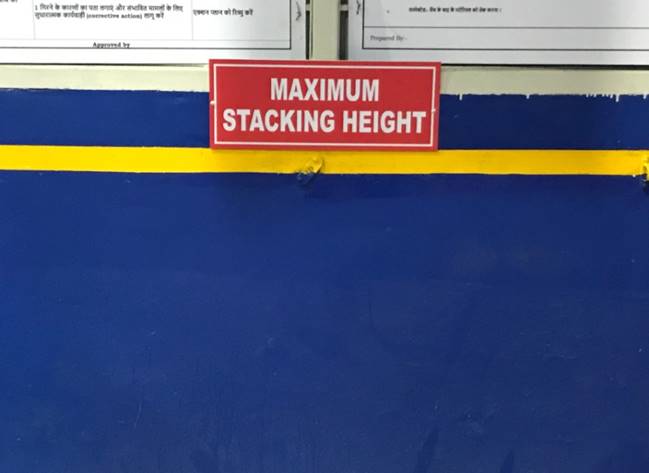
This kaizen helped improve safety and it is an example of point Kaizen.
#2 Case Study
Problem Statement: High Tool Set-up Time.
Description: One of our clients was facing a high set-up time issue. We made a spaghetti Diagram for the process and we observed the operator was moving to and fro to get various tools for set-up as per need. The number of trips was as much as 9 trips per set-up.
To avoid these many trips we designed the following trolley. Which has all the tools in one place? Tools are properly identified on the trolley. The operator can move the trolley to the station where set-up has to be done. It reduced the number of trips from 9 trips to 1 trip per set-up.
It led to a reduction of 25% set-up time.
This kaizen is an example of a flow kaizen.
#3 Case Study
Problem Statement: FIFO is not followed in the RM area.
Description: One of our clients was facing an issue with maintaining FIFO in the RM area. Leading to Inventory waste. We implemented a FIFO BOARD as shown below.
For implementing the FIFO board we identified the RM location for each RM Rack and designated it a unique number.
Channels on the FIFO board contain location cards for every material grade. Cards are to be entered from one direction and moved forward. Material as per location on the First card towards the outer section of the channel is the oldest material and hence should be used first.
This is an example of the system Kaizen.
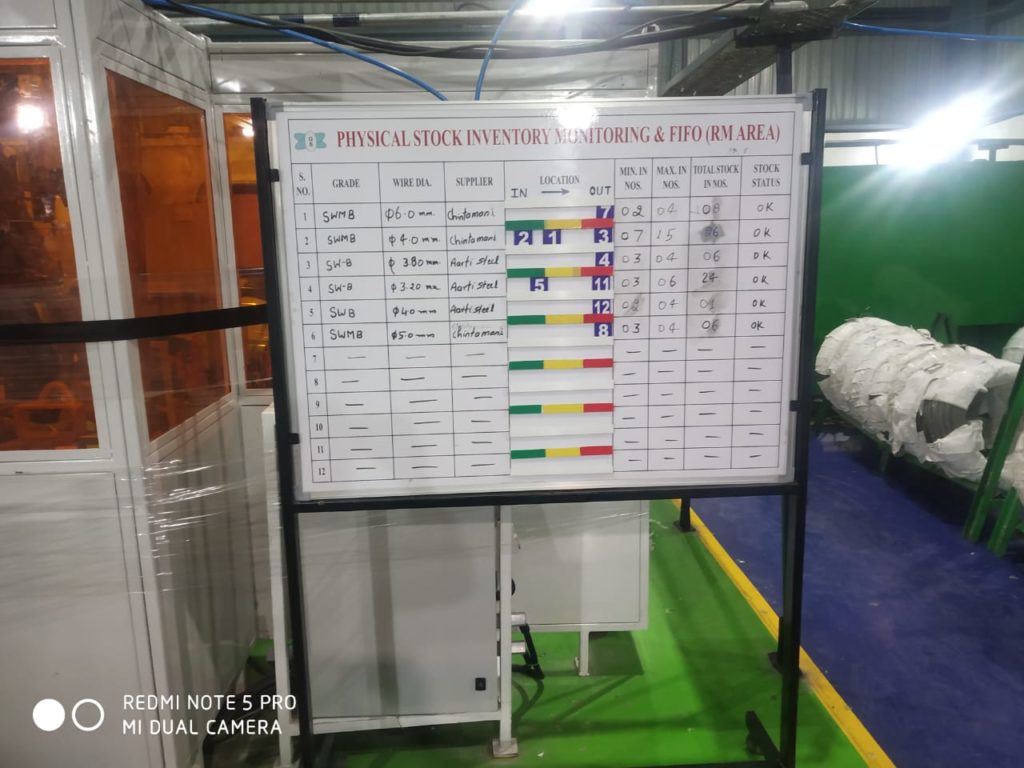
FAQs
Kaizen V/s Lean
There are many similarities between kaizen and Lean Manufacturing, but there are also some key differences.
Both philosophies emphasize continuous improvement and the elimination of waste, but kaizen takes a more gradual, incremental approach while Lean Manufacturing is more focused on achieving short-term results.
kaizen also places a greater emphasis on employee involvement and creativity, while Lean Manufacturing is more focused on streamlining processes and eliminating waste.
How does kaizen help improve product quality?
Kaizen helps improve product quality by encouraging employees to come up with new ideas for improving quality and productivity. When employees are creative and innovative, they’re more likely to come up with new ideas that can help improve quality and productivity. kaizen can also help businesses save money by reducing the need for rework and repairs. By taking small steps and involving everyone in the organization, kaizen can lead to big improvements over time.
I hope this article was helpful.
In the comment section tell us one Kaizen you did.
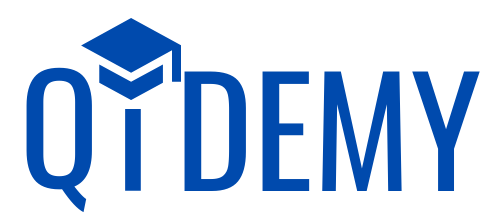
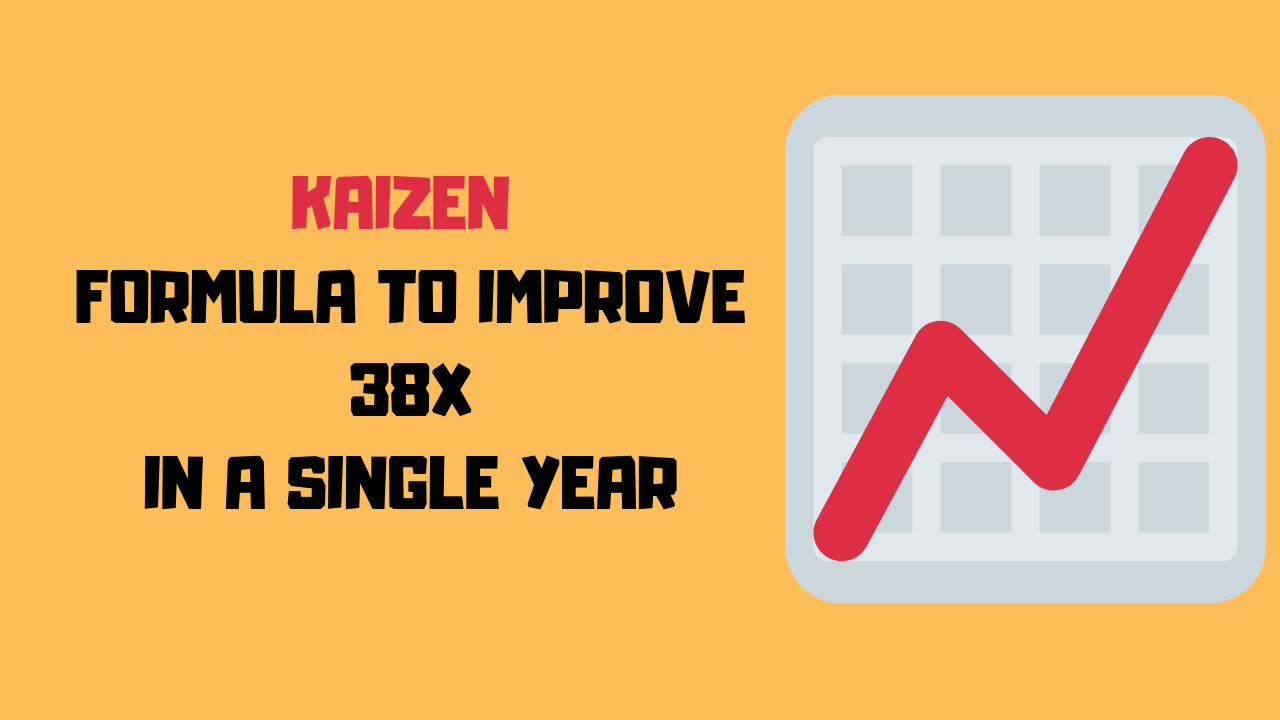
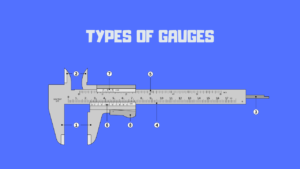


I抦 now not positive the place you’re getting your information, but great topic. I must spend some time studying more or working out more. Thanks for magnificent info I was searching for this information for my mission.
Thank you for the sensible critique. Me & my neighbor were just preparing to do a little research on this. We got a grab a book from our local library but I think I learned more from this post. I’m very glad to see such fantastic information being shared freely out there.